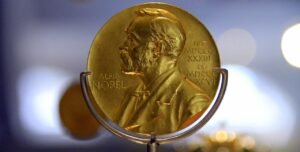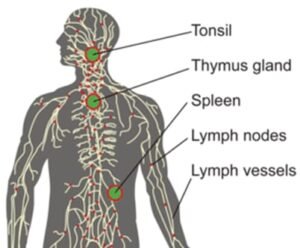Nobel Prize in Medicine 2025
|
General Studies Paper II: Important International Institutions, Important Personalities |
Why in News?
In October 2025, the Nobel Prize in Physiology or Medicine was awarded to Mary E. Brunkow, Fred Ramsdell, and Shimon Sakaguchi for their pioneering work on immune system regulation that opened new avenues for treating autoimmune diseases.
Who are the winners of the 2025 Nobel Prize in Physiology or Medicine?
- Mary E. Brunkow: Mary E. Brunkow (1961) is an American molecular biologist and immunologist. She earned her Bachelor of Science in molecular and cellular biology from the University of Washington. Later, she obtained both her Master of Arts and Ph.D. in molecular biology from Princeton University in 1991, under the guidance of Shirley M. Tilghman. Her doctoral research focused on the expression and function of the H19 gene in transgenic mice. She is affiliated with the Institute for Systems Biology in Seattle, Washington.
- Fred Ramsdell: Frederick J. Ramsdell (1960) is an American immunologist. He completed his Bachelor of Science in biochemistry and cell biology at the University of California, San Diego, in 1983. Subsequently, he earned his Ph.D. in microbiology and immunology from the University of California, Los Angeles, in 1987. Ramsdell’s doctoral research focused on generating lymphokine-activated killer cells from non-natural killer cell sources. He is serving as the Research Director at the Parker Institute for Cancer Immunotherapy in San Francisco.
- Shimon Sakaguchi: Shimon Sakaguchi (1951) is a distinguished immunologist. He graduated from the Faculty of Medicine at Kyoto University in 1976 and obtained his Ph.D. from the same institution in 1982. Sakaguchi’s postdoctoral research at Johns Hopkins University and Stanford University as a Lucille P. Markey Scholar furthered his expertise in immunology. He served as an Assistant Professor in the Department of Immunology at the Scripps Research Institute before returning to Japan in 1991. Currently, Sakaguchi is a Distinguished Professor at the Immunology Frontier Research Center at Osaka University.
What did they Discover?
- In 1995, Shimon Sakaguchi made a breakthrough in immunology by challenging the existing belief that immune tolerance was maintained only in the thymus. At that time, most researchers thought that harmful immune cells were removed in a process called central tolerance. Sakaguchi showed that the immune system was far more complex. He identified a new type of immune cells, which he later called regulatory T cells. These cells prevent the immune system from attacking the body’s own tissues.
- In 2001, Mary E. Brunkow and Fred Ramsdell advanced Sakaguchi’s work through genetics. They studied a special strain of mice prone to autoimmune disease. They discovered a mutation in a gene they named Foxp3. This mutation disabled the immune system’s ability to regulate itself. As a result, the mice developed severe autoimmune conditions. Their research connected regulatory T cells to a specific gene that controls their function.
- They found that mutations in the human version of Foxp3 caused IPEX syndrome, a rare and severe autoimmune disorder. This condition leads the body to attack its own tissues from an early age. Their findings provided a genetic explanation for this disease. It also confirmed the critical role of regulatory T cells in controlling immune tolerance.
- In 2003, Sakaguchi connected the dots between his cellular discoveries and the genetic work of Brunkow and Ramsdell. He demonstrated that the Foxp3 gene orchestrates the development of regulatory T cells. Without Foxp3, these cells cannot develop properly. This explained why the immune system sometimes attacks the body itself. Sakaguchi’s work completed the picture of peripheral immune tolerance.
- The combined research of these three scientists explained how the immune system avoids self-harm. They showed that regulatory T cells act as guardians, ensuring that defensive reactions only target harmful microbes.
Significance of this Discovery
- Explaining Autoimmune Protection: The discovery of regulatory T cells explains why most people do not develop serious autoimmune diseases. These cells control the immune system and prevent it from attacking the body’s own tissues. Before this research, the mechanisms of immune self-tolerance were poorly understood.
- New Treatments for Diseases: The discovery opened new paths for treating autoimmune conditions. Scientists can develop therapies that enhance or restore the function of regulatory T cells. These therapies aim to prevent the immune system from attacking healthy organs.
- Advancing Cancer Therapies: Understanding regulatory T cells also benefits cancer research. These cells influence how the immune system responds to tumors. By controlling or modifying regulatory T cell activity, researchers can boost anti-cancer immune responses. This new immunotherapy approaches to target cancers more effectively.
- Improving Organ Transplant: Regulatory T cells help prevent the immune system from rejecting transplanted organs. Therapies based on Foxp3 gene and regulatory T cells are being tested to increase transplant success rates. These advances could make transplants safer and improve long-term survival for patients.
|
Understanding the Human Immune System
|
What is the Nobel Prize?
- Origin: The Nobel Prize was established in 1895 by Alfred Nobel, a Swedish inventor, engineer, and philanthropist. Nobel invented dynamite and earned great wealth through his inventions. In his will, he dedicated his fortune to creating awards that recognize outstanding contributions to humanity. The first prizes were awarded in 1901.
- Award: Each Nobel Prize includes a gold medal, a diploma, and a cash award. The cash amount varies and is decided by the Nobel Foundation. Winners often deliver lectures explaining their work.
- Fields: The Nobel Prize is awarded in six main fields: Physics, Chemistry, Physiology or Medicine, Literature, Peace, and Economic Sciences. Each field honors exceptional work that benefits humanity. The Peace Prize is awarded in Oslo, Norway, while all other prizes are presented in Stockholm, Sweden.
- Eligibility: Candidates for the Nobel Prize can be individuals or organizations. Nominations are submitted by experts, professors, and previous laureates. There is no age limit or nationality restriction. The work must be original and have a significant impact in its field. Self-nominations are not allowed.
- Selection Process: The selection process is rigorous and confidential. Committees review nominations and consult external experts. They evaluate the significance, originality, and impact of the work. The committees submit recommendations to the Nobel Assembly or relevant institutions. Final decisions are made by vote, usually several months before the award ceremony in December.
- Specific Committees: The Nobel Prizes are awarded by specific committees and institutions for each field. The Royal Swedish Academy of Sciences selects winners for Physics, Chemistry, and Economic Sciences. The Nobel Assembly at Karolinska Institute awards the Physiology or Medicine prize. The Swedish Academy chooses the Literature laureates, while the Norwegian Nobel Committee awards the Peace Prize.
|
Also Read: 2024 Nobel Prize in Physiology or Medicine |











